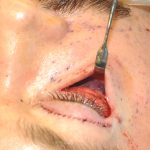A very common patient concern is that of dark circles under the eyes. While patients frequently try a variety of creams to improve the dark discoloration that they see, they are usually chasing the wrong ‘rabbit’. Most dark circles problems are really a tear trough deformity, an indentation problem that is creating a shadow effect which casts an image of a tired and older lower eye appearance.
The tear trough affects the inner aspect of the lower eyelid and appears as a visible concavity or indentation. While associated usually with an early sign of aging, some patients have it naturally as a true anatomic defect. The tear trough is at the junction of the very thin lower eyelid skin with the thicker nasal skin superiorly and slants downward into the cheek area over the lower eye socket bone. Because herniated fat from the lower eyelid may and often exists above it, the tear trough can look quite deep in some patients. Women may often camouflage this area with make-up.
A key question is why does the tear trough exist? In an extremely insightful article in the February 2010 issue of the journal Plastic and Reconstructive Surgery, it is pointed out that volume loss is the primary reason. As the face ages, we lose fat and this facial area may be one of the very first to show it given its thin tissues and the lack of any significant fat between the skin and the underlying orbicularis muscles. For those with a more natural or congenital tear troughs, it may be how the complex array of underlying muscles merge and interdigitate that accounts for this triangular medial lower eyelid and cheek deformity.

By far, however, injectable fillers remain the most common treatment method particularly in the younger patient. While many injectable fillers exist, the safest and most versatile are the hyalurons. (e.g., Restylane, Juvaderm, etc) These gels give good and easy flow and that is important when injecting into this thin and delicate area where bruising can easily occur. When bruising occurs in the lower eyelid, it will likely be three weeks or so before it resolves.
One of the keys to tear trough injections is to not think that it is a ‘single shot’ injection that is placed just under the skin. That will undoubtably lead to both inadequate and poor results with a visible bulge. One has to think of going into and beyond the tear trough area as well as deep to the muscle. The material must go between the muscle and the bone. Multiple needle passes are needed followed by massage an filler manipulation. A smooth result must exist at the end of treatment.
Interestingly, the length of injection filler treatment of the tear trough is longer than what one experiences in the rest of the face. (e.g., lips or nasolabial folds) This must be related to the lack of any significant motion in this area. Many patients will experience at least a year of sustained improvement.
Dr. Barry Eppley
Indianapolis Indiana


